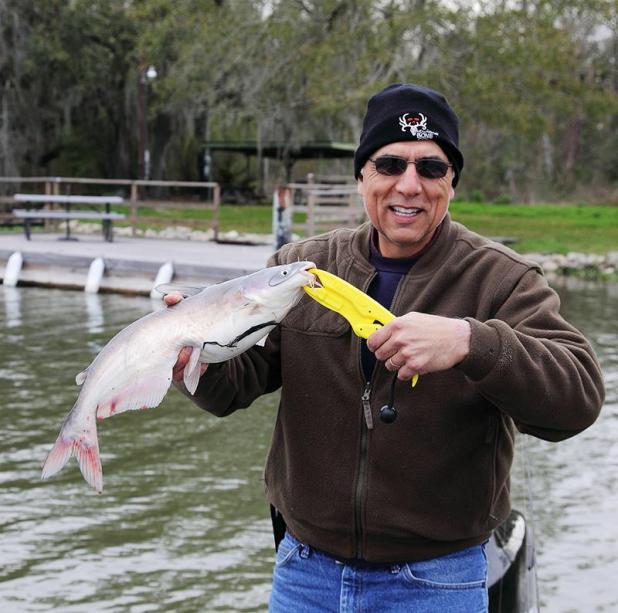
John Flores with a catfish he caught on an April morning
(Submitted Photo/Courtesy of John K. Flores)
Internal spring time clock signals time to fish blue cats
My father-in-law was a marsh man who dreaded coming home from down the bayou after trapping season. In fact, more than dread, he hated it. Doing anything to extend his stay during the latter part of March right on into April, he’d put out spanner-lines along the coast and commercially fish blue catfish.
One of the things I learned by observing his behavior was when he put out lines, it was time for Mrs. Flores and me to get in the boat with our rod and reels.
Typically, the bayous are all open along the coast at this time of year, where most of the water hyacinth hasn’t grown all that much since winter. It’s also the time of year when blue catfish are really active, and it’s not uncommon for catfish anglers to sit in one location and fill up an ice chest during a morning outing.
My father-in-law James Duay is not around these days, nor is he calling to tell me the caisse vivre (the crate where the fish were kept alive) was full. Moreover, or to let me know he sold more than 100 pounds of fish at the dock that day, so I’d better hurry up and get down there before he caught them all.
Times do change, but each spring, I always know when it’s time to fish catfish. No doubt his prodding was designed to instill something in me that couldn’t be erased from my internal time clock, where each April, I’ll start checking out a few likely spots to fish.
The expanse of marsh around these parts also has become a sea of purple iris in full bloom starting the latter part of March on into April. Alligators slowly slide into the cool water as you round each bayou bend. And the coast is alive with shorebirds like dowitchers, stilts, willets and plovers.
It was during an April morning at the camp my father-in-law and I were throwing a cast net to catch some bait for his lines. We watched a huge 12-footer crawl up on the bank and holler for its mate. The water popped off his gnarly back like droplets of rain splashing on the concrete. All of this means it’s time to be on the water.
My wife Christine is a drop-rig tight line fisherwoman with a sensitive touch who literally talks to catfish, coaxing them to bite. Her technique reminds me of a time when every kid in our generation at one time or another took two vegetable cans and stretched a string between them making a homemade telephone.
I truly believe when she is tight line fishing for catfish, her voice goes down the 15-pound test fluorocarbon loaded on her closed-face reel and they hear her enticement the same way those cans worked. Never have I been on a trip with her when this Neptunian conversation doesn’t happen and a blue cat winds up in the boat.
“Just don’t play with it. Take it,” Christine will say.
The next thing you know, my 5-foot, 2-inch spouse gives a lip-ripping yank on her rod similar to Kevin Van Dam setting the hook on a Lake Cataouatche Bass. At that very instant a “Woo-hoo” shout that I find only girls actually can do correctly comes from her, and another catfish winds up on ice.
She’s also someone who knows what works for her and sticks with it. When digging through our tackle box, she’ll often say, “Where are my hooks?”
“What hooks?” I’ll reply from the opposite end of the boat, acting like I’m fishing.
“You know! My hooks,” she’ll insist.
By “my hooks,” what she meant was O’Shaughnessy 2/0 hooks of any brand like Eagle Claw, Mustad or Gamakatsu. O’Shaughnessy hooks are simply a solid dead-bait hook. The eye is large, which makes it easier to tie or clip into a drop rig. Its design is durable, which makes it able to withstand the rigors large blue catfish will put the hook through. And it also holds bait well.
For her drop rig, she’ll also use a ¾ ounce pyramid sinker to ground her tight line communication system. The key is matching the sinker to the current speed without losing the feel of a fish bite.
Along the Atchafalaya Bay tributaries, where my spouse and I fish, there are typically higher rates of salinity in the early spring. One of the things noted in an abstract from a study conducted by W. Guthrie Perry Jr. of the Louisiana Department of Wildlife and Fisheries near Grand Chenier in the western part of the state was blue catfish tolerate higher salinity than channel catfish and are able to handle salinities of 3.7 parts per thousand, compared to 1.7 ppt channel cats tolerate.
As a result, what we’ve found is there seems to be a preponderance of blue cats versus channel cats at this time of year.
Channel catfish, also known as willow, eel and yellow catfish by the old timers, seem to prefer skinny, more shallow waters like narrow bayous and pipelines that drain into larger deeper bayous and rivers. Each spring when the water is cool, channel cats often can be caught in the backwaters.
There’s no doubt springtime is the best time for fishing catfish, no matter what part of the state you’re fishing. For Mrs. Flores and me, it’s usually when the iris are in bloom, the alligators still are moving kind of slow, and the shorebirds have returned to our marshes. That time is April.
